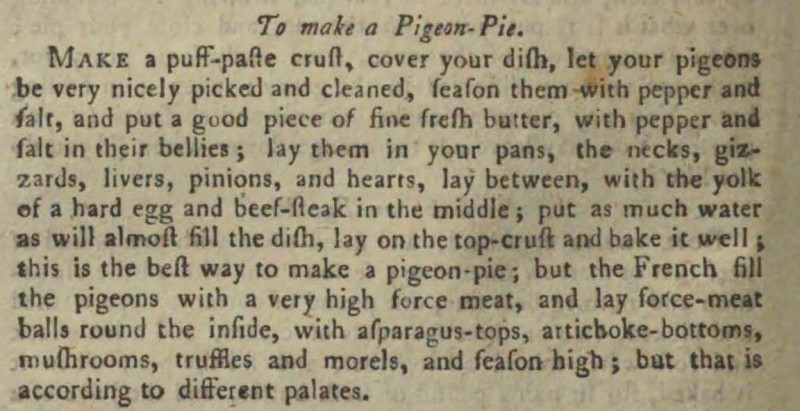As noted in Dining with Jane Austen II: No Such Thing as Lunch?, dinner shifted from noon-time to evening over the course of the 18th century, but this change occurred slowly and unevenly, with the result that certain households - especially those with claims to urbanity and fashion - might eat their main meal of the day much later than others. In Sense and Sensibility, The Dashwoods dine at 4pm at home in Barton Cottage, but in London, Mrs. Jenning’s begins dinner at 5 o’clock. In Pride and Prejudice, dinner is served at Longbourne at 4:30, but the fashionable Bingleys bring their London hours to Netherfield and dine at 6:30pm.
Early in Pride and Prejudice, Mrs. Bennet plans a two course meal in honor of her daughter Jane's love interest, Mr. Bingley, but it does not come to fruition, as he is called away to London. Fortunately, she has another opportunity in Chapter 53, when Mr. Bingley and Darcy return to Netherfield, whereupon, “she did not think anything less than two courses could be good enough for a man on whom she had such anxious designs, or to satisfy the appetite and pride of one who had ten thousand a year.”
Today, we generally understand a “courses” to mean specific dishes of particular flavors served in succession. For example, in a restaurant, a "three-fourse meal” might include an appetizer followed by a main savoury dish succeeded by dessert. However, in Georgian terms, a “course” involved a wide variety of different dishes - often of both sweet and savory flavors - served on the table simultaneously. As Deirdre Le Faye notes in The Jane Austen Cookbook, a single course could be comprised of anything from five to twenty-five dishes on the table at once.
A family dinner would usually consist of just one course, but a company dinner offered at least two. The host would be responsible for supervising the serving of soup and carving of meat during the first course of soup, fish, meat, and related side-dishes. Once the diners had eaten what they wished to from a selected dishes near them, the table was cleared and sometimes an intermediate dessert of cheese or salad before a second varied, often slightly-lighter course, would be served, before the table was cleared and a final dessert was laid out on a clean cloth or the polished table. This dessert usually consisted of nuts, fruits, cheese, and sweetmeats, accompanied by port, Madeira, and sweet wine.
While no details of Mrs. Bennet’s table are provided, we can imagine what it might have looked like based on recorded accounts of Georgian dinners. In The Jane Austen Cookbook, Miss Catherine Hutton’s account of a 1779 dinner describes a company dinner in a moderately well-off genteel household thus:
“At three o’clock we sat down to table, which was covered with salmon at top, fennel sauce to it, melted butter, lemon pickle and soy; at the bottom a loin of veal roasted; on one side kidney beans, on the other peas, and in the middle a hot pigeon pie with yolks of eggs in. To the kidney beans and peas succeeded ham and chickens, and when everything was removed came a currant tart...After dinner we had water to wash [that is, in finger-bowls[, and when the cloth was taken away, gooseberries, currants and melon, wines and cyder.”
A French visitor to England in 1810-1811 described a “moderate dinner” with a first course of oyster sauce, fish, spinage, fowls, soup, bacon, vegetables, and roasted or boiled beef; a second course of creams, ragout, celery, pastry, cream, macaroni, cauliflowers, game, and pastry; and a dessert of walnuts, apples, raisins and almonds, cakes, pears, and oranges.
Recipes for many of the dishes featured in these dinners may be found in books such as Hannah Glasse’s The Art of Cookery (1796 ed.), Elizabeth Raffald’s The Experienced English Housekeeper (1806 ed.), or The Young Woman’s Companion (1811 ed.).
For those seeking a simple way to add a Georgian touch to their own fish course, Elizabeth Raffald suggests the following recipe “To make Sauce fo a Salmon,” perhaps similar to that enjoyed by Miss Hutton:

The Experienced English Housekeeper... by Elizabeth Raffald. Published and sold by booksellers and by T. Wilson and
R. Spence, printers, 1806. Page 24. Janice Bluestein Longone Culinary Archive.
“BOIL a bunch of fennel and parsley; chop them small, and put it into some good melted butter, and send it to the table in a sauce-boat.”
And for the truly ambitious, Hannah Glasse offers instruction on how “To make a Pigeon-Pie:

The Art of Cookery Made Plain and Easy... (1796 edition) by Hannah Glasse, printed for T. Longman in London. Page 194. Janice Bluestein Longone Culinary Archive.
MAKE a puff-paste crust, cover your dish, let your pigeons be very nicely picked and cleaned, season them with pepper and salt, and put a good piece of fine fresh butter, with pepper and salt in their bellies; lay them in your pans, the necks, gizzards, livers, pinions, and hearts, lay between, with the yolk of a hard egg and beef-steak in the middle; put as much water as will almst fill the dish, lay on the top-crust and bake it well; this is the best way to make a pigeon-pie; but the French fill the pigeons with very high force meat, and lay force-meat balls around the inside, with asparagus-tops, artichoke-bottoms, mushrooms, truffles, and morels, and season high; but that is according to different palates.
Bibliography:
Black, Maggie and Deirdre Le Faye. The Jane Austen Cookbook (Toronto : McClelland & Stewart, 2002).
Lane, Maggie. Jane Austen and Food (London: The Hambledon Press, 1995).